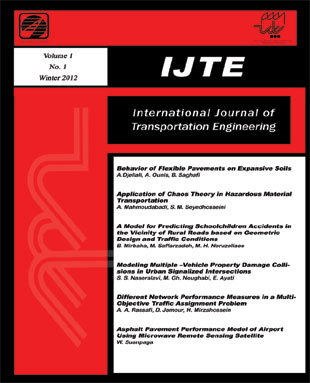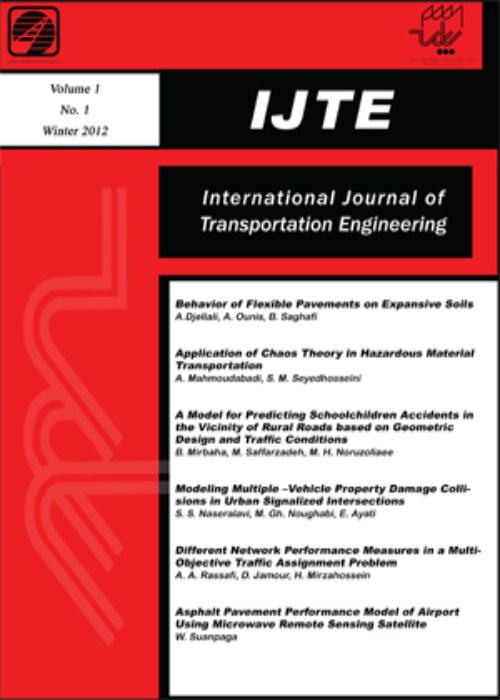فهرست مطالب

International Journal of Transportation Engineering
Volume:1 Issue: 1, Winter 2013
- تاریخ انتشار: 1391/11/24
- تعداد عناوین: 6
-
-
Page 15Risk factors are generally defined and assigned to road networks, as constant measures in hazmat routing problems. In fact, they may be dynamic variables depending on traffic volume, weather and road condition, and drivers’ behavior.In this research work, risk factors are defined as dynamic variables using the concept of chaos theory. The largest Lyapunov exponent is utilized to determine the presence of chaos for road accident rates. Risk factors with the property of chaotic behavior are considered to solve hazmat routing problem using a developed mathematical model. Evaluation process has been done based on travel distance which mainly represents travel cost, as well as results show that theapplication of chaos to define dynamic risk factor is an appropriate method to solve hazmat routing problem, comparing to constant measures of risks.Keywords: Risk analysis, chaos theory, hazmat routing problem, transport distance, cost
-
Page 25Students are among the most vulnerable road users because of their age, physical characteristics and the scale of awareness they gain from their surroundings. Recent statistics indicate that pedestrians are involved in about 40 percent of fatalities in rural areas of Iran. Meanwhile, about 29 percent of pedestrian fatalities were under 18 years old. Based on the fact that almost two million Iranian students study in the vicinity of rural roads, this paper aims to develop a model for predicting the risk of students’ accidents near the aforementioned schools. Therefore, by gathering data from schools located in rural areas, schools are divided in three categories as follows: no risk (no accidents/ year), medium risk (one accident/year), and high risk (two or more accidents/year). A multinomial logit (MNL) model has been chosen and the utility function was considered as a combination of variables such as road width, functional speed, presence of school guardian, number of students and the ratio of average daily traffic to the distance of schools from roads. Results indicate that the proposed model can predict the risk of accident occurrence with the accuracy of more than 70 percent. Meanwhile, school guardian is known as an important variable in the prediction model. Also, results show the important role of the road width and proposed ADT/Dis variables.Keywords: Student's accidents, schools in the vicinity of roads, accident prediction model, multinomial logit, school guardian
-
Page 35Development of disaggregate models for estimating different property damage collision type frequencies in urban intersections has rarely been studied, particularly in Iran. It seems that very little research work has been implemented for studying the factors affecting the collision type frequency at intersections. The main objective of this paper is to develop suitable statistical models to predict types of property damage accident frequencies at signalized intersections approaches in the City of Mashhad, Iran, based on geometric, traffic and regulatory control characteristics. Three negative binomial models are estimated for collisions occurred in four-leg signalized intersections in the city of Mashhad and their results were compared. These models are total, rear-end and right angel collision models. The goodness of fit was assessed by statistic tests. The Incidence Rate Ratio is used to assess the effectiveness of independent variables on frequency of property damage collision. Validation of models was controlled using paired samples T test Method. Modeling collision types showed a strong relationship between frequency of property damage collision types and independent variables such as road geometry, the type of control system and traffic characteristics. Results revealed that seven of independent variables considerably affect the safety of signalized intersections.Keywords: Property damage collision, signalized intersection, negative binomial model
-
Page 47Traffic assignment algorithms are used to determine possible use of paths between origin-destination pairs and predict traffic flow in network links. One of the main deficiencies of ordinary traffic assignment methods is that in mostof them one measure (mostly travel time) is usually included in objective function, and other effective performance measures in traffic assignment are not considered. The current study is an endeavor to introduce a solution for this problem by applying a multi-objective optimization idea to traffic assignment models. To do this, a problem with three objective functions including travel time, total traveled distance and the rates of cabin monoxide emissions are studied first, and then problem with two objectives combining two well-known assignment approaches i.e. user equilibrium and system optimal is introduced. Using the weighting method to solve the multi-objective problem, andcomparing the results, show that the analytical relationships resulted from weighting method is applicable to different networks. Furthermore, comparison of both multi-objective and single-objective problems (travel time only) showed that the results of proposed model are more appropriate in terms of having a plenary view to this issue, and thus more useful.Keywords: Multi, objective optimization, traffic assignment, Pareto optimal solution, user equilibrium
-
Page 59The purpose of this study is to build the binary logit model of an airport pavement that could monitor the pavement condition in near real time using microwave remote sensing satellite, then the relationship between theinternational roughness index (IRI) of an airport and backscattering values from PALSAR images of the ALOS satellite was determined. Total 390 data were used in analysis. This model could be applied to evaluate theefficiency of the quality of running service on the airport pavement. The analysis showed that the backscattering values in the HH and HV polarization have correlated with IRI, and HH polarization was the highest correlation withIRI value (r = 0.90). If the backscattering value in HH polarization is increased, the roughness will be increased. After the validation process on other 100 data, the result presented high correlation at 94.00%. Therefore, it can be concluded that this model could be applied to the airport pavement maintenance.Keywords: PALSAR, airport pavement, binary logit, IRI, microwave remote sensing


